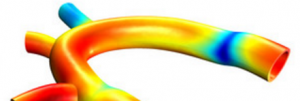The Worcester Polytechnic Institute (WPI) is currently developing a surgical robot that will also be able to work within the powerful magnetic field emitted by MRI scanners. Piezoelectric motors have an important role to play.
Surgeons so far have faced a dilemma when it comes to treating brain tumors: they can use magnetic resonance imaging (MRI) to take high-resolution images of the tumor— or they can remove the tumor using precise surgical instruments. They cannot do both at the same time.
The Worcester Polytechnic Institute (WPI) is now developing a surgical robot that is designed for use within an MRI scanner. Using image guidance, the robot can position the surgical instrument exactly at the identified site of the tumor. The WPI team of Prof. Greg Fischer ran into considerable challenges developing the robot, however. During surgery, the instruments have to be positioned accurately under repeatable conditions with high resolution. The instruments may not produce electromagnetic interference, have to be very reliable, and—in the case of the MRI robot—have to work in powerful multiple-tesla magnetic fields. Combinations of electromagnetic motors and gears cannot be used. So the option fell on a piezoelectric-based system—a unique type of motor that can meet all the requirements listed above.
These actuators are based on a piezoelectric ceramic material that expands under the influence of electrical voltage. But only in very small dimensions: the displacement produced by the piezoelectric effect is only a fraction of a percent of the component’s size. In the case of an MRI robot, however, a linear travel path of up to about 100 mm was needed, and the motor also needed to allow for continuous 360-degree rotation. The WPI team found the solution in the Piezo Legs motors made by Piezo Motor, a company of the German Faulhaber Group. These motors were developed for precise and energy efficient “move-and-hold” applications.
One of the robot’s tasks is to penetrate tissue. To do so, it requires linear motion, which the WPI team implemented using a combination of Piezo Legs linear motors in a direct drive. Piezo Legs rotary motors were used as the drive. The rotary motion is transmitted through pulleys that were made in the 3D printer.
Overcoming the friction that is generated is no problem for the piezoelectric drive. “We get by with a low gear reduction, regardless of whether we are using a Piezo Motor in a direct drive or with a pulley,” explains Fischer. Gear reduction ratios in a magnitude of 100:1, as needed in a small DC motor, are not an issue here.
The piezoelectric actuators require only very small conductive electrodes that have to be non-magnetic and non-ferrous in the MRI environment. But those are not all of the requirements for this application. Any electromagnetic interference can distort the image created by the MRI scanner. It would cause objects to appear somewhere other than expected, and Fisher says that is “a very big problem when you are letting imaging guide you during an intervention.”
So the British team developed an individual controller to operate piezoelectric motors in the MRI scanner. The controller is based on a field-programmable gate array (FPGA), rapid digital-to-analog converters, and broadband high-speed linear amplifiers. External filters suppress any interference and an encoder feedback system makes it possible to control position or speed using a single-board microcontroller running on real-time control software.
The modular backplane, which can hold up to eight of these boards, is held in a single shielded casing that is located in the MRI scanner room along with the robot. An application-specific cable harness connects the controller to the robot and can control up to eight axes. What made this complex project easier was that the linear and rotary piezoelectric motors were available immediately as stand-alone components.
The WPI has a few things in mind for the future: Fischer wants to make a toolbox that can be used to develop MRI-compatible robots that are equipped with sensors, actuators, controllers, and amplifiers and that can be controlled over communication protocols. “In the industry, all you have to do is combine a commercially available PLC, a motor, or an encoder and you’ve got a functioning system,” says Fischer. “This kind of product does not exist for medical technology devices—and especially not for MRI applications.”
There are even a few variants available for the MRI robot, for example, for precision thermal ablation in brain tumors, the positioning of electrodes for deep brain stimulation used to treat Parkinson disease, or targeted, MRI-guided biopsy for prostate cancer. “We are aiming to create very compact and application-specific solutions,” comments Fischer. “They are all based on the same motors that have proven very effective for us.”
Andreas Seegen Dr. Fritz Faulhaber, Schönaich, Germany
How Piezo Legs Motors Work
Theoretically the displacement facilitated by the motors limits how the Piezo Legs motors work. The motors are composed of piezoelectric actuator systems. When voltage is present, they react asymmetrically; one side expands while the other retracts, resulting in a bend.
When arranged and controlled as alternating pairs, these elements can move a drive rod in nanometer steps with speeds of up to 15 mm/s, so they just keep “walking” the drive rod forward.
With rotary motions, a disk starts spinning in the same way at a correspondingly fast rate. In this process, the actuators are self-contained, do not need any power when switched off, do not heat up, and keep the position mechanically stable.
Teilen:







